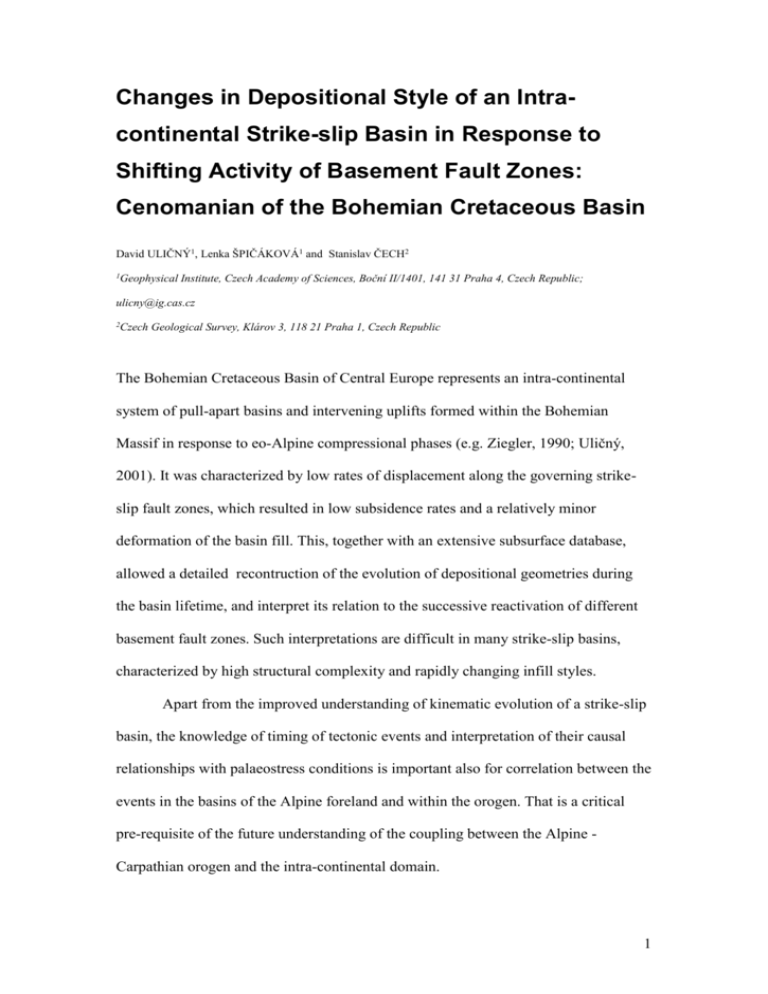Lenka ŠPIČÁKOVÁ and David ULIČNÝ
advertisement

Changes in Depositional Style of an Intracontinental Strike-slip Basin in Response to Shifting Activity of Basement Fault Zones: Cenomanian of the Bohemian Cretaceous Basin David ULIČNÝ1, Lenka ŠPIČÁKOVÁ1 and Stanislav ČECH2 1Geophysical Institute, Czech Academy of Sciences, Boční II/1401, 141 31 Praha 4, Czech Republic; ulicny@ig.cas.cz 2Czech Geological Survey, Klárov 3, 118 21 Praha 1, Czech Republic The Bohemian Cretaceous Basin of Central Europe represents an intra-continental system of pull-apart basins and intervening uplifts formed within the Bohemian Massif in response to eo-Alpine compressional phases (e.g. Ziegler, 1990; Uličný, 2001). It was characterized by low rates of displacement along the governing strikeslip fault zones, which resulted in low subsidence rates and a relatively minor deformation of the basin fill. This, together with an extensive subsurface database, allowed a detailed recontruction of the evolution of depositional geometries during the basin lifetime, and interpret its relation to the successive reactivation of different basement fault zones. Such interpretations are difficult in many strike-slip basins, characterized by high structural complexity and rapidly changing infill styles. Apart from the improved understanding of kinematic evolution of a strike-slip basin, the knowledge of timing of tectonic events and interpretation of their causal relationships with palaeostress conditions is important also for correlation between the events in the basins of the Alpine foreland and within the orogen. That is a critical pre-requisite of the future understanding of the coupling between the Alpine Carpathian orogen and the intra-continental domain. 1 In the present study, a detailed genetic-stratigraphic framework within a fluvial through shallow-marine clastic succession of Cenomanian age was used to assess the relative differences in subsidence rates and the timing of phases of tectonic and geomorphological evolution of the central part of the basin during the initial stage of its filling. Although precise chronostratigraphic correlation is difficult in the lower part of the Cenomanian package (the Peruc-Korycany Formation), dominated by fluvial-estuarine facies, the flooding surfaces, correlated with confidence between well-logs, provide nearly isochronous correlation markers allowing local timeresolution at the level of tens of ky. Regional genetic-stratigraphic units (CEN1CEN6) bounded by the most prominent flooding surfaces allow resolution of individual tectonic phases at a time scale well below 1 My. In the central part of the Bohemian Cretaceous Basin, two significant basement fault systems, inherited from the Variscan orogeny, were reactivated during the mid-Cretaceous inception of the basin filling. The WNW - trending Labe Fault Zone sensu stricto, and the Lužice Fault Zones, belonging to the Elbe Zone sensu lato, were reactivated as a broad, dextral strike-slip fault zone. The NNE-oriented Blanice/Rodl Fault Zone, conjugate to the Labe Fault Zone, had an antithetic (sinistral) sense of displacement. These fault systems had been reactivated several times prior to the mid-Cretaceous, notably during the Late Palaeozoic evolution of post-orogenic extensional-transtensional basins. The earliest stage of the Cretaceous deposition in the region (Middle Cenomanian) was characterized by fluvial infills of palaeovalley system. In the region studied, NNE –trending Blanice/Rodl fault system, controlled the trends and the topography of a major NNE-oriented palaeovalley. This was joined by an array of tributaries aligned with the WNW “Elbe” structural trend and, locally, by the ENE- 2 trending fold and fault pattern of the Palaeozoic Barrandian terrane. The main palaeovalley ran parallel to the present-day Jizera River, and was superimposed on the central part of the Late Palaeozoic Mnichovo Hradiště Basin. This stage was followed by a transition towards an estuarine system resulting from further flooding of the palaeovalley system, and, finally, towards widespread shallow-marine deposition in a setting of generally uniform subsidence rates, with the exception of several palaeohighs. During this time, the clastic input from the southern-southeastern source areas, which dominated the initial fluvial phase, decreased. A marked change in stratigraphic geometries occurred during the Late Cenomanian when a new depocenter formed along the WNW-trending Lužice Fault Zone, approximately during the Metoicoceras geslinianum ammonite zone, sourced from a block uplifted along the northern margin of this zone. This led to a new basinfill geometry dominated by a wedge of shallow-marine sandstones prograding from the active marginal faults of the Lužice Fault Zone and thinning towards the S-SE, accompanied by a rapid flooding of remaining local source areas within the basin. This change was related to an increased rate of dextral displacement along the Lužice FZ and a formation of a typical pull-apart geometry of the Lužice-Jizera sub-basin, and thus marks a transition to the basin-fill style that prevailed during most of the basin lifetime. The overall kinematic picture of the basement structures during the Cenomanian allows an interpretation of the far-field principal stress axis (1) as oriented generally NW-SE, bisecting the conjugate set of the Blanice-Rodl FZ and the Labe FZ. The causal mechanism of the temporal change in relative activity of the two fault systems is not straighforward, however. The simplest explanation favoured by the authors involves a minor counterclockwise rotation of 1 during the Cenomanian 3 and is described below. We infer that the initial phase was characterized by a NNW orientation of 1, favouring sinistral movements along the Blanice-Rodl FZ and parallel fracture systems, whereas the final phase, dominated by dextral movements on the Elbe Zone fault system, would correspond to a lower angle between the NWoriented 1 and the Labe and Lužice FZ, with a resulting higher efficiency of dextral strike-slip to oblique-slip along these faults which became the governing structures of the basin. The transition between the two phases occurred over a short time interval within the Late Cenomanian, not longer than several hundred ky. This research was financially supported by the Ministry of Environment of the Czech Republic, contract No. OG-9/02. References: ULIČNÝ, D., 2001. Depositional systems and sequence stratigraphy of coarsegrained deltas in a shallow-marine, strike-slip setting: the Bohemian Cretaceous Basin, Czech Republic. Sedimentology, 48, 599-628. ZIEGLER, P. A., 1990. Geological Atlas of Western and Central Europe: Shell Internationale Petroleum Maatschappij, The Hague, 239 p. 4





